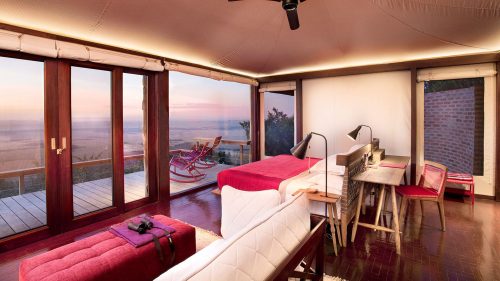
In Angama’s Photographic Studios, we have the great fortune of working with some of the top professional cameras available. Of course, we each have our secret favourites — one of us might prefer the Sony and the other may be Canon all the way, but one thing we all agree on is the incredible powers of the phone camera.
With every new generation of phones, we are continually impressed by the quality of the cameras and the content that you can capture from the palm of your hand. These days you can do more than just ‘point and shoot’ and we’re giving more phone photography lessons than ever before.
In many cases, a telescopic lens is the best piece of equipment for wildlife photography and most guests coming into the Studio want to rent one of our lenses. They even make lenses now that connect to phones or phones to binoculars, called digiscoping. However, sometimes the animals come incredibly close to the vehicles, making the great big lenses completely redundant. Not only that, but a safari holiday is not just about the wildlife and your phone is more than able to help you capture moments around the lodge and of your family and friends on your adventure.
Portrait mode, once a novelty, has become a staple in smartphone photography, offering huge control over depth of field. The ability to adjust the aperture allows for portraits with beautifully blurred backgrounds, making them look professional. These are perfect for capturing images of your loved ones on safari or even some of the Angama team that you have spent time with.
Time-lapse mode unlocks the magic of time, allowing users to capture life unfolding. Taking a photograph every second for several seconds, time-lapses are fantastic at showing change and work really well to capture sunrises and sunsets. The biggest trick is to find a place where you can leave your phone that captures one or two bits of movement in the shot (e.g. the clouds moving).
Live photos add another dimension to smartphone photography, capturing a brief snippet of motion alongside every still image. This dynamic element not only breathes life into photographs but also allows users to choose the perfect moment from a continuous stream of frames, enhancing creative control and storytelling. This is ideal for moving subject matter such as the Maasai performing at Boma or moments at the lodge like the one below.
Another easy way to take your phone photographs to the next level is by using the editing tools integrated into your smartphone. From basic adjustments like cropping and exposure to more advanced techniques like colour grading and retouching, these tools help make your photographs look more professional and captivating.
For those seeking even greater control and flexibility, third-party editing apps like Snapseed and Adobe Lightroom are a great option. From advanced colour grading to selective adjustments, these apps provide professional-grade tools in the palm of your hand. They also have great presets that take a lot of the guesswork out of your editing.
But perhaps the most exciting developments in smartphone photography lie in the realm of videography. You can record videos in 30 or 60 frames per second, depending on what quality you would like your videos at. 30 Frames per second is more than enough for everyday shooting but if you want more professional videos then change your settings. While the normal video mode is perfect to capture every beautiful moment on your safari but it’s not the only option...
Cinema mode is like portrait mode for video; you can control the F-stop to change the depth of field. So, similarly to portrait mode, it captures your subject in full detail while blurring the background, allowing for cinematic storytelling with a little flair. Slow-motion mode is another exciting option that allows you to capture the beauty of fleeting moments in detail — think a butterfly landing on a flower or the Maasai jumping at Sunset Boma.
When you're next at Angama, visit the Photographic Studio and let us help you unlock the power of your photography with your phone.
Filed under: Stories from Angama
Subscribe for Weekly Stories
Comments (0):

Tented Suites